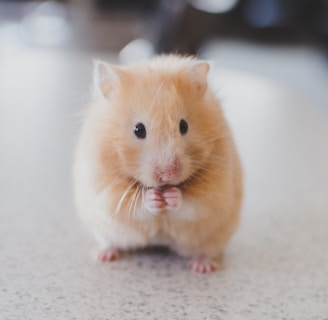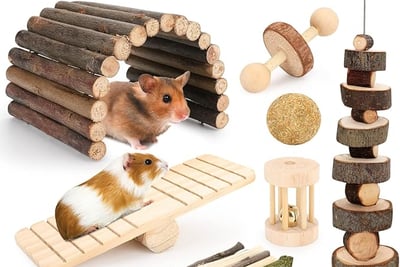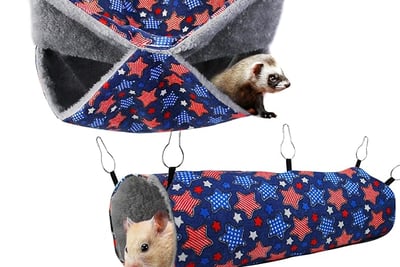Bringing Home a Rodent: A Guide to Care and Space Requirements
8 min read


Understanding Your New Pet
When considering a small animal as a pet, hamsters, mice, and rats are popular choices due to their manageable size, relatively simple care needs, and engaging personalities. Understanding the characteristics and behaviors of these rodents is essential for making an informed decision about which pet best aligns with your lifestyle.
Hamsters, known for their solitary nature, come in several breeds such as the Syrian and dwarf hamsters. These small creatures are nocturnal and typically spend their days sleeping in nests constructed from bedding material. They are playful and can be interactive, exhibiting a range of charming behaviors such as running in wheels and exploring tunnels. The lifespan of a hamster generally ranges from two to three years, making them a suitable choice for those seeking a shorter-term commitment.
Mice, in contrast, tend to be more social and thrive in groups. Their lively behavior and curious nature can provide endless entertainment to their owners. Mice can be trained to recognize their names and can even learn a few tricks. With an average lifespan of about two years, potential owners should consider that these sociable creatures often benefit from having companions to interact with, fostering a more content living environment.
Rats are often underestimated but are highly intelligent and affectionate pets. They possess a remarkable ability to form strong bonds with their owners and can be trained to perform various tasks or navigate complex mazes. Rats also have a lifespan of about two to three years and appreciate social interaction, whether with humans or other rats. Their playful demeanor and emotional intelligence often surprise new owners, leading to a rewarding pet ownership experience.
In summary, understanding the unique characteristics and behaviors of hamsters, mice, and rats will guide potential pet owners in choosing the right pet to suit their personal lifestyle, ensuring a harmonious and fulfilling relationship.
Choosing the Right Space for Your Pet
Creating a suitable habitat for your new pet rodent is critical for their overall health and wellbeing. Hamsters, mice, and rats have varying needs when it comes to the size and layout of their living spaces. For hamsters, a minimum cage size of 450 square inches with a height of at least 12 inches is generally recommended. These energetic creatures require ample floor space to roam and explore, as well as vertical space for climbing and enrichment features such as tubes and platforms.
Mice, being smaller and social creatures, can adapt to a slightly smaller enclosure. Ideally, a cage that offers at least 360 square inches of floor space is suitable for a colony of mice. While they enjoy living in groups, it's vital that the cage promotes good airflow and provides multiple hiding spots to foster a sense of security. Horizontal and vertical enrichment, such as shelves and tunnels, should be included to allow natural behaviors to flourish.
Rats require a larger, multi-level space due to their size and social nature; a minimum of 2 cubic feet per rat is essential. An appropriate rat cage should ideally possess several levels, consistent connectivity through ramps or ladders, and proper ventilation to prevent odor buildup. Accessibility is especially important when choosing a cage for rats, as they need safe and easy ways to explore their environment without encountering hazards such as sharp edges or escape routes.
Moreover, ensuring proper ventilation in all cages is crucial. This prevents moisture buildup and keeps the living environment hygienic. The layout of the cage should allow for easy cleaning, while also incorporating elements that promote physical and mental stimulation. Providing a comfortable and secure habitat is essential to cultivating a happy and healthy life for your pet rodent.
Dietary Requirements and Nutrition
Understanding the dietary requirements of hamsters, mice, and rats is essential for ensuring their health and well-being. These small rodents have specific nutritional needs that must be met to prevent health issues and promote longevity. A balanced diet consisting of both commercial pellets and fresh foods is vital for their overall nutrition.
Commercial pellets formulated specifically for each species provide the necessary base nutrition. These pellets typically contain essential protein, fiber, and vitamins required for growth and maintenance. For hamsters, specially formulated blends should be selected to ensure they receive adequate protein levels due to their active nature. Mice also thrive on high-quality rodent pellets, which often include a mix of grains and seeds. Rats are omnivorous and benefit from a varied diet but should also have access to specially designed pellets to meet their nutritional needs.
In addition to pellets, supplementing their diet with fresh fruits and vegetables is highly beneficial. Hamsters enjoy carrots, cucumbers, and apples, while mice can be offered small pieces of bell peppers and broccoli. Rats, being particularly versatile in their diet, can have a wider range of vegetables, but it’s important to introduce new foods gradually to monitor any reactions. Leafy greens, such as spinach and kale, provide additional vitamins, but they should be served in moderation.
Feeding schedules should be established, typically providing fresh food once daily while ensuring that clean water is always available. Portion sizes will vary based on the species and individual animal's needs, but a general guideline is to avoid overfeeding, as obesity can lead to serious health risks. Lastly, certain foods are to be avoided entirely, such as citrus fruits and chocolate, as they can be toxic. Taking the time to learn and implement these dietary requirements is crucial for any pet owner looking to maintain the health of their hamsters, mice, or rats.
Creating a Comfortable Environment
Establishing a cozy and stimulating environment for your pet hamster, mouse, or rat is essential for their well-being. The first step in creating this space is to select suitable bedding materials. Fleece blankets, aspen shavings, or paper-based bedding are excellent choices, as they provide comfort while also helping to control odors. Avoid cedar or pine shavings, as the oils can be harmful to small animals. The bedding should be deep enough to allow your pets to burrow, which is a natural behavior that contributes to their happiness.
In addition to bedding, enriching your pet's environment with various toys and activities is crucial. Chew toys made from natural wood or cardboard offer both entertainment and dental health benefits. Consider adding tunnels and climbing structures to promote active play. Exercise wheels are another vital aspect; they help to provide physical exercise that your pet would naturally engage in if they were in the wild. Make sure the wheel is solid and appropriately sized for your pet to ensure safety and comfort during use.
Hiding places are equally significant in creating a supportive habitat for these creatures. Small wooden igloos, hidey houses, or tunnels give them a sense of security and a private space to retreat when feeling stressed. Burrowing and hiding are innate behaviors that help small pets feel safe and can significantly reduce anxiety. You can enhance their environment further by incorporating elements such as hammocks or climbing ropes that encourage exploration.
Overall, environmental enrichment is key to keeping hamsters, mice, and rats actively engaged and mentally stimulated. By combining comfortable bedding, engaging toys, exercise opportunities, and secure hiding places, you can create a nurturing environment that promotes the physical and psychological health of your new furry family member.
Routine Care and Maintenance
Ensuring the well-being of your small pet, be it a hamster, mouse, or rat, requires a consistent routine for care and maintenance. Daily habits play a critical role in both their happiness and health. For instance, checking their food and water supply should be a paramount activity. Fresh water must be provided daily, and food should be portioned appropriately to prevent overeating, which can lead to obesity.
Cage cleaning is another vital aspect of this routine. It is advisable to remove soiled bedding and uneaten food daily to maintain a hygienic habitat. A thorough cleaning should occur weekly, which involves removing all bedding, washing the cage with mild soap, and replacing the bedding with fresh materials. This not only keeps the environment clean but also helps to prevent health issues caused by bacteria or mold.
Health monitoring is essential as well. Observing your pet for any changes in behavior, appetite, or physical appearance can serve as crucial indicators of their health status. Pets may exhibit signs of stress or illness, such as excessive hiding, lethargy, or unusual vocalizations. Recognizing these signs early can lead to prompt veterinary attention if necessary.
Handling techniques also play a significant role in the overall care routine. When handling your pet, it is important to be gentle and cautious to establish trust. Gradually introducing your new pet to bonding experiences can foster a healthy relationship, making them more comfortable when handled. Offering treats during this process can be an effective way to help your pet associate your presence with positive experiences. By investing time in these practices, you will ensure your pet thrives in their environment while also enjoying a rewarding companionship.
Socialization and Interaction
When considering the care of hamsters, mice, or rats, it is crucial to recognize their social needs and interaction requirements. Despite their small size, these animals possess distinct personalities and exhibit varying levels of sociability. Understanding how to handle and interact with your pet not only improves their quality of life but also fosters a stronger bond between you and your furry companion.
Hamsters, in general, are more solitary creatures. It is essential to provide them an environment where they can explore and exercise. While some species, like the Campbell’s dwarf hamster, can live in pairs, it is often better to house them individually to prevent territorial aggression. Regular handling of your hamster, starting from a young age, can help develop trust. Always scoop them gently from below, rather than grabbing them abruptly, allowing them to feel secure during interaction.
In contrast, mice and rats are highly social animals that thrive in the company of their kind. They often do well in pairs or small groups, as their social structure mimics that of a colony. When introducing new pets, ensure that they are introduced gradually and in neutral territory to prevent conflicts. Understanding their body language can also significantly improve interactions. Signs of relaxation, like lying flat or grooming, indicate a comfortable pet, whereas tail biting or excessive squeaking may point to stress.
Regardless of the species, consistent interaction is key. Regular handling will not only help to socialize your pet but will also reduce stress during routine husbandry procedures such as cleaning their habitat. By integrating interaction into their daily routines, owners can foster a positive environment that supports the health and well-being of their small pet.
Frequently Asked Questions
When considering the introduction of a hamster, mouse, or rat into your home, potential pet owners often have numerous questions. Addressing common concerns can provide clarity and confidence for those looking to bring one of these small rodents into their lives. One of the first inquiries pertains to the lifespan of these pets. Generally, hamsters live about 2 to 3 years, while mice can have a lifespan of 1.5 to 2 years. Rats, on the other hand, typically live longer, often reaching an age between 2 to 3 years if well cared for. Understanding these lifespan expectations can aid in planning for the long-term care of your new companion.
Another frequent question involves the compatibility of these rodents with other pets. When introducing a hamster, mouse, or rat to a household with existing pets, it’s critical to consider their personalities. Generally, hamsters are solitary creatures that can often be territorial, making them less compatible with other rodents. Mice, however, tend to be social and can thrive with same-gender companions. Rats also benefit from socialization, ideally living in pairs or groups, which enhances their wellbeing. When introducing any of these rodents to other pets, close supervision is essential to ensure safety and minimize stress for all animals involved.
Typical costs associated with caring for hamsters, mice, and rats are also an essential consideration. Initial expenses may include the purchase of a suitable cage, bedding, food, and toys, amounting to roughly $100 to $200. Ongoing costs, such as food, bedding, and necessary veterinary care, can add up to approximately $15 to $30 monthly. Thus, being well-informed about both initial and recurring expenses will aid potential owners in making sound financial decisions as they welcome their new furry friends.











